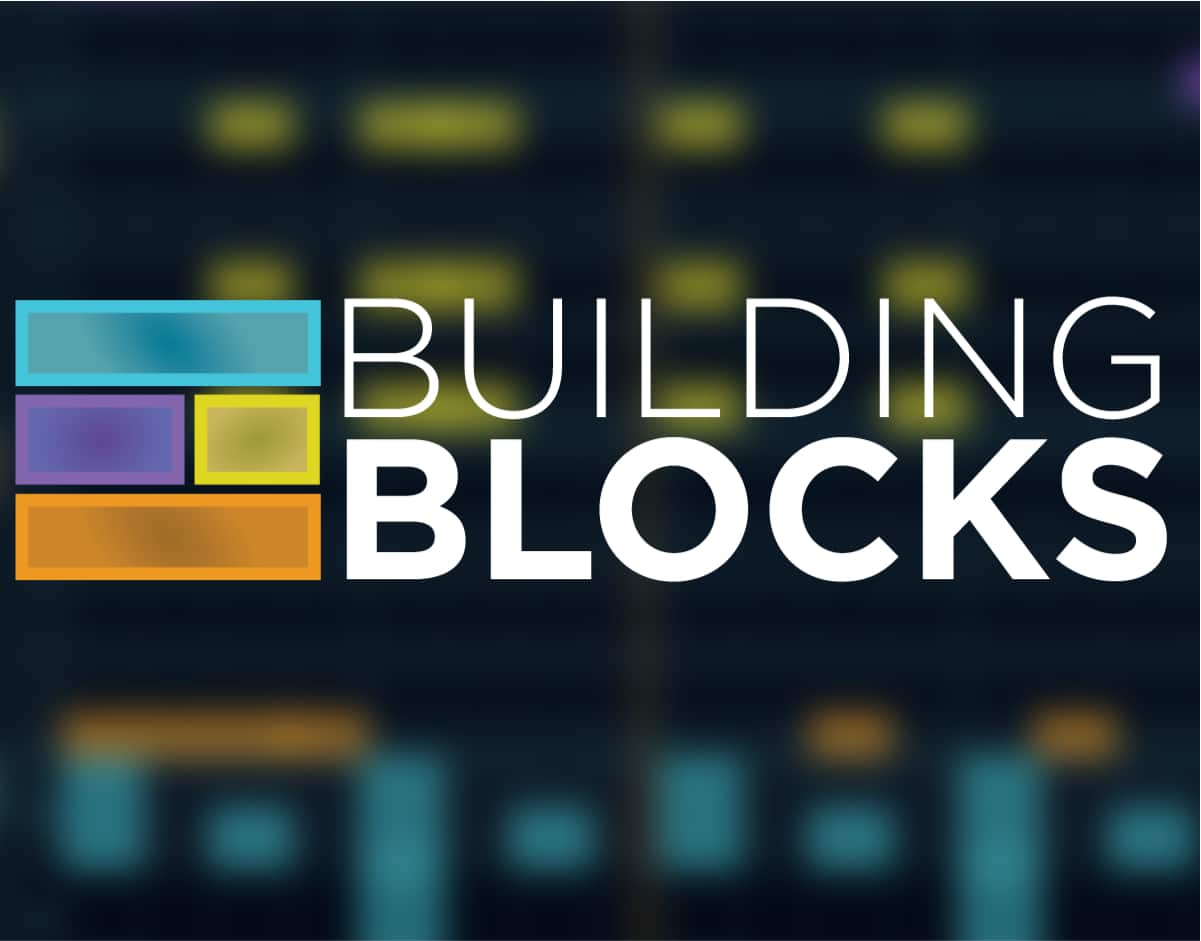So I have been trying out a new music theory and production training software called Building Blocks.
You might be familiar with the company, Audible Genius and the other program they created, Syntorial.
Syntorial made a big name for itself in the producer world by helping novices learn the techniques of sound design while teaching you to hear with a more critical ear.
This will be my complete review of using Building Blocks.
In this review, I’ll cover my honest thoughts on…
- Who this course is suited for
- Important features
- Why this it is unique
- How it compares to other similarly priced tools
- Whether or not it is worth it
- How to start using it
- Why you should (or shouldn’t) buy it
I wrote a lot of this while I was going through the course so that everything was fresh in my mind.

What is Building Blocks by Audible Genius?
Building Blocks is more than a simple course. It is an interactive course teaching music theory and composition in a way that is specifically tailored to the needs and learning style of DAW-based music producers.
As the name suggests, you will learn the building blocks of music — Drums Patterns, Basslines, Chord Progressions, and Melodies — in this DAW-like training environment (We will go into more detail on this later).
If you have ever tried to learn music theory from a textbook, you already know how dry that experience can be, but…just imagine you are learning this with hands-on challenges in a DAW.
That is what Building Blocks is.
Building Blocks by Audible Genius Review
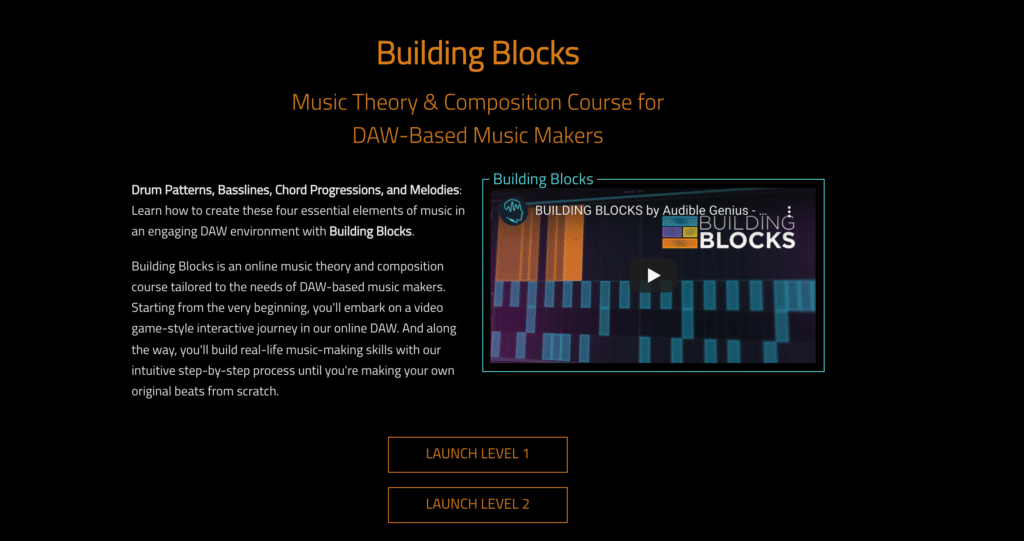
Overview
Building Blocks is currently divided into two-course, Building Blocks 1 and Building Blocks 2. These build off of each other and combined these courses amount to over 180 interactive lessons.
You will take a journey through the course encountering various types of lessons and challenges to ingrain the knowledge
You can look forward to learning new skills that will take your music production skills to the next level.
Here are a few things you can expect to do and learn:
- Practical Music Theory for Producers (with great insights from the teacher)
- Ear training & Challenges to reinforce concepts
- Creating your own original music
- Place to make beats and experiment right in your browser (that you can export later)
Curriculum / Course Content – 10/10

One of the first things you notice when you jump into the lessons is how down-to-earth Joe is and how well he can communicate his musical knowledge in the lesson videos.
The first few lessons are able to teach you important concepts about Drums, the topic of this section, while onboarding you to the navigation and user interface of Building Blocks.
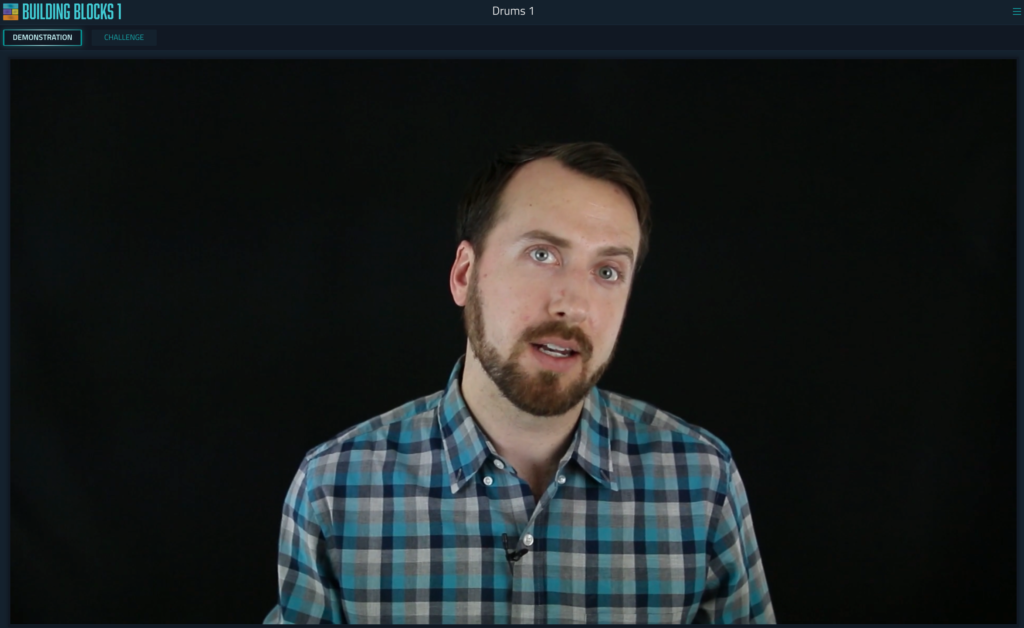
Each lesson starts with a short video that introduces a few concepts and the goal of the lesson. These are short and concise and I was constantly amazed by unique nuggets of knowledge or explanation of topics that are usually overly difficultly explained in traditional music theory textbooks.

As this is mainly aimed at producers, he starts the course with Drums and Bass, which are considered the foundation of most pop and electronic music.
We will get into the various topics found in the Building Blocks course,
but I think we should start with introducing you to each lesson format…as you won’t find lessons designed like these in any other course.
Let’s jump into it.
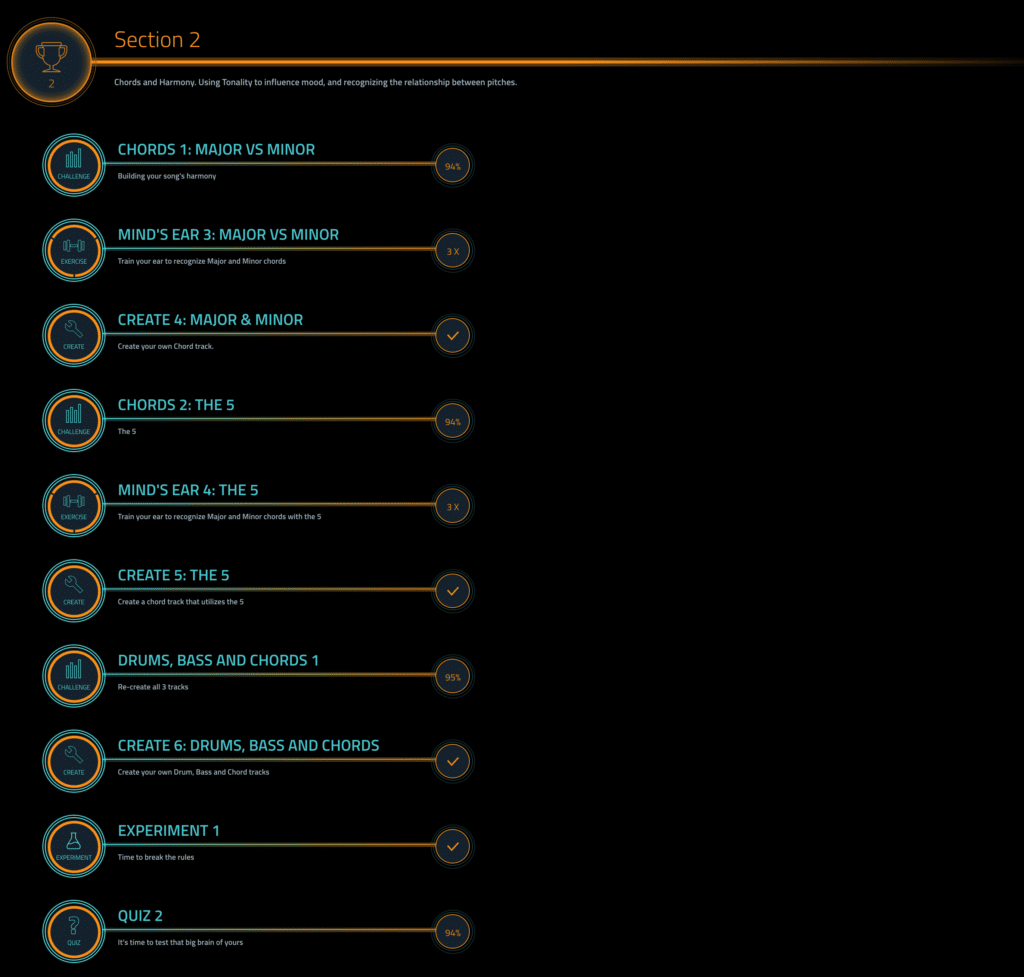
Lesson Types
As you go through each section of the course you will about 5 or 6 types of lessons that will introduce you to a new topic or help you internalize a concept through practice. Some of these formats you will be familiar with, and others you won’t. Let’s start with the most important lesson types.
Challenges
In Building Blocks, The Challenge lessons are built to introduce you to a concept through the video that accompanies it. Then, you have to immediately recreate a piece of given music that uses that musical concept in the challenge section of the lesson.
The Challenge part takes place in the course itself so there is no need to open your own DAW.
I know at times that has always been a minor inconvience to be following along with a course and have to switch back and forth between your DAW, watching the video, switching back and forth, and eventually getting too distracted.
Basically, you are bought into the Building Blocks DAW and have to listen to a piece of music, but you can not see the note placements. You then switch over to the visible side, where you can see where you place yoru notes, and try to recreate what you hear. You can continually switch back and forth until you think you got it perfect.
Mind’s Ear
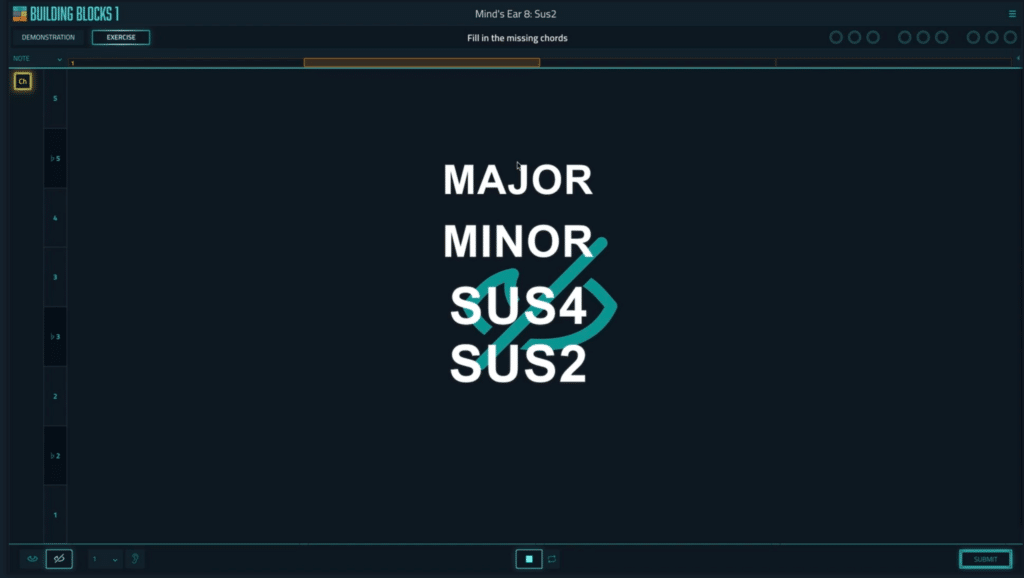
If you thought this would be another ear training lesson, then you thought right. But there is an interesting twist that makes this even more challenging than the challenge lessons.
As you will learn when you go through the course, there is a ear training skill that the challenge lessons don’t help build.
And that skills is what Joe describes as your mind’s ear.
Your mind’s ear is the the sound that you have in your head, and developing this will allow you to express your ideas accurately and more quickly.
Now, what exactly do you have to do in the Mind’s Ear lesson?
You are given 1 measure of music that will play on the hidden side, but when you switch you the visible side to input the notes..you will not hear the notes as they are placed in the piano roll. You will have to rely on your mind’s ear.
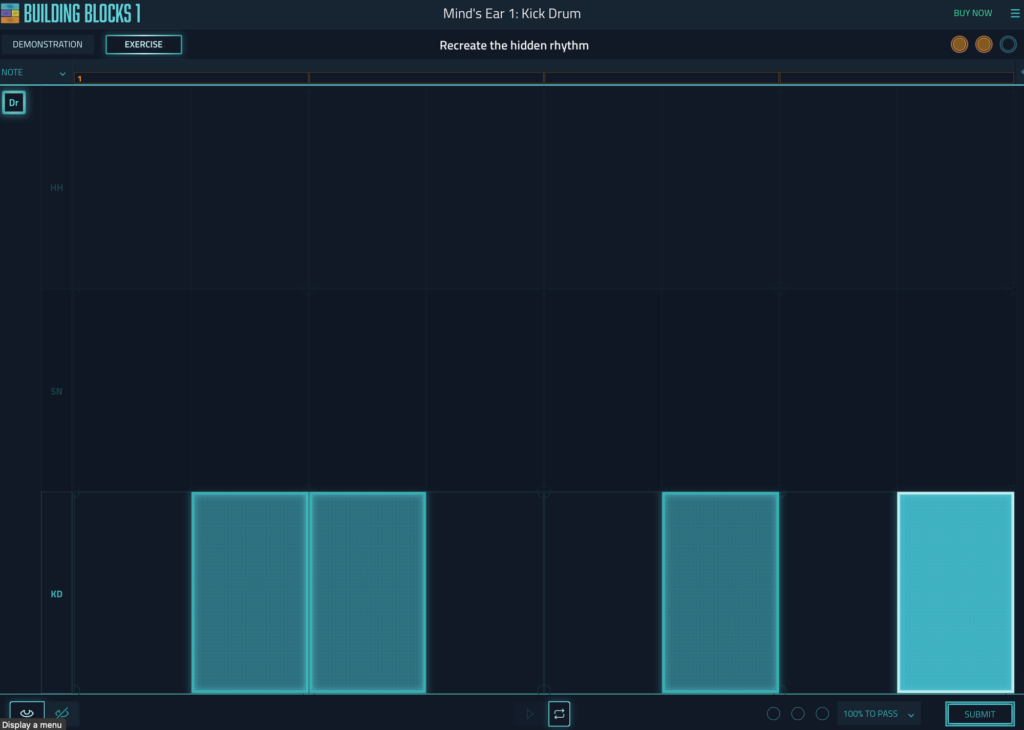
This idea behind doing this is that when you are making music in the real world you are going to want to be able to recreate what you have in your mind very quickly because those sounds and ideas can mutate very quickly.
If you can’t get it out of your head accurately and quickly, you will likely forget it or it will gradually change as you try to get it down on your instrument or DAW.
I’m not a total beginner and I have some prior experience with ear training in college and through other resources, but I found these Mind’s Ear lessons are the most practical. Once you do a few, you will feel a gradual change to how you feel the music and rhythm as you produce music in the real world.

BENEFITS of the Challenges and Mind’s Ear Exercises
You are probably thinking….cool, I already know ear training is important, but I tried it before and it didn’t really help me.
You may have even used ear training apps from Musictheory.com, Ear Master, or some kind of audio CD program
I know I have plenty of experience experimenting with them and eventually giving up because I didn’t feel any benefits. I know those programs work, but they often take a lot of consistent effort over a long period of time. Many of the exercises, especially the beginner levels, won’t translate to getting better in the real world..

Unless you are working with nursery rhymes. Down for a Row Row your Boat collab?
The Mind’s Ear and Challenges immediately throw you into ear training by hearing full chords in context with bass and drums.
You will have to focus that much more to discern the harmony because when you want to do this in the real world, you are not going to have the luxury of listening to the melody or chord tracks in isolation.
These exercises prepare you to learn how to dissect your favorite songs or tracks, which is a key skill to improving as a musician.
Whether you want to call it transcribing, reverse engineering, or recreating this technique of ear training when bought out to is the best way to learn ear training, music theory, songwriting and form.
You probably saw my first attempt, but after some more practice I was able to improve gradually and this happened.
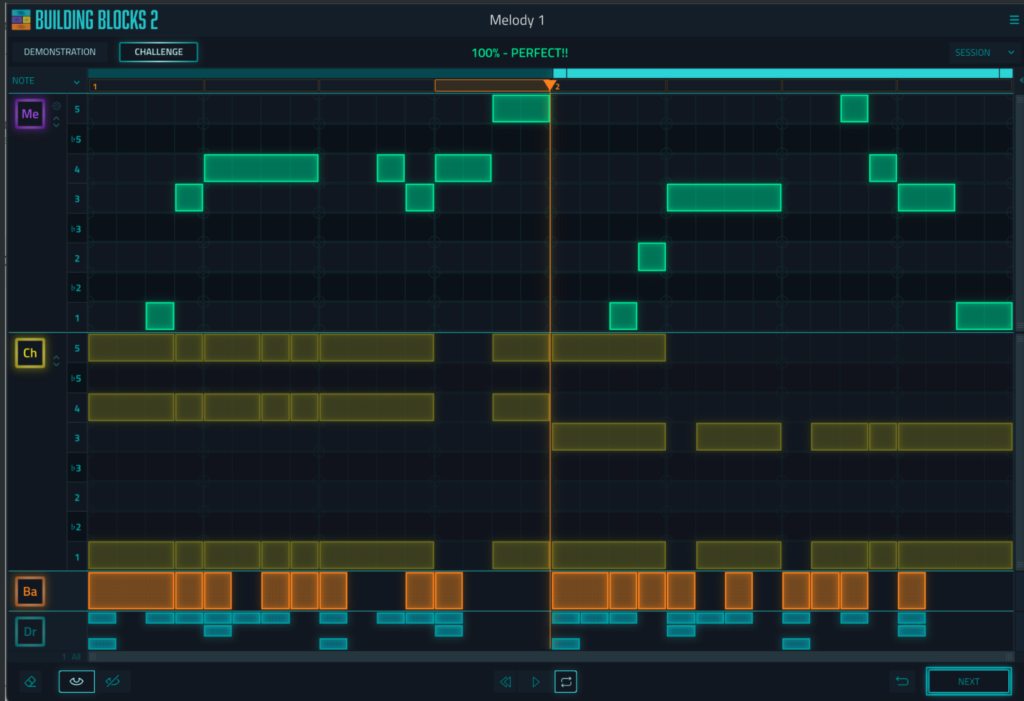
Create

Let’s make this fun…how many times can I use the word create in this section.
Time to get creative with the Create lessons.
You get to take the knowledge you have gained through the previous lessons and apply them to creating your own music in the Building Blocks DAW.
To start off, you get a short video reviewing some of the concepts guidelines you have learned and then told to ignore them if you want.
Depending on where you are at in the course, the Create Lesson’s mission will be different, but you are feel to create how you want. For example, the 1st section of the course is all about drums so you are going to be creating only drum beats during this section
But as you advance further into the course, you will be creating drums, bass, harmony, and melody.
After you finish a create lesson they give you the option to save this in the Building Blocks DAW so you can use this piece of music again later or export it.

Quiz
This is a short multiple-choice quiz that checks to see if you have actually been watching the lesson videos…you have haven’t you? Not much to say on these except you should find them fairly easy with some interesting questions.
Experiment
After the quiz, there is usually an experiment lesson. You know, so you can really drill in those “RULES” Joe has been explaining in the lessons, or so you might think!
It is actually to make you forget about those “RULES” and experiment with what you feel sounds good. Sorry Joe..I let the secret out.
You are told to use the techniques that have been shown and break them however you see fit.
This is the time to have fun and so something that isn’t technically right! That’s how good shit is born right?
Sing
Everyone knows how to hum a little tune. And it was with this idea in mind that this lesson type was created.
Not everyone has the skills and technical ability to translate the sound in their head into an instrument or even into their voice without lots of dedicated practice.
Even then, unless you have developed your ear, getting these ideas out fast enough so that they don’t transform into something else and disappear.
The sing lessons teach you how to use clapping or humming to create a beat or melody. Sounds simple enough and you may have even heard of someone do that.
I know Andrew Huang just records a bunch of nonsense words when he is making a scratch melody or scratch vocal line.
But have you actually done it? Too much trouble to set up?
Well, you can record your humming or clapping directly into the Building Blocks DAW interface, and then recreate them with the drums, bass, and chord piano roll.
Personally, I found this to be the most fun part of the course, even though I found it the most difficult at first.
But once you get a few takes down and you get into a groove, things sound better and your ideas start to flow better once you get over being self-conscious
Topics and Course Outline
Building Blocks One
- Foundation with Drums and Bass
- Into to Chords and Harmony Major and minor
- 16th notes more complex rhythms
- Sus4 and Sus2 chords, Resolutions
- Velocity. Giving drums life
- Arpeggiating Chords / More pitches for bass
- Snare variation
- Chord progressions, bass, and snare
- Chord Pargeggiation/Bass Pitch/ Take off the training wheels
Building Blocks 2
- Melody Writing
- Drum Variation Hihats and snare alternatives
- Chord Progression – Changing roots
- Basslives and Melodies over Chord changes / Toms
- Anticipating Chord Changes / half time
- Pitches with flat 6
- Grooves and 4-bar progressions
- 7ths
- Chord Inversions
Difference Building Blocks 1 and Building Blocks 2
The courses are split into two separate levels. It is split this way because Building Blocks 2 begins to introduce the all important top-line of the song, the melody.
The reason, I’m assuming, that melody wasn’t introduced in Level 1 is because it wanted to focus on the foundational elements – rhythm, bass, and harmony before adding melody to the mix.
That would be pretty overwhelming for the less experienced producers and musicians.
I think most of this content would cover most of the knowledge you would learn in the first semester of a music theory course. It doesn’t go into depth about the different keys, but since it is teaching music theory using relative notion it is beginner friendly and allows you to simply focus on the music, not memorizing the different keys. You can do that later down the road…
Building Blocks Level 2 also goes deeper and explains more advanced concepts in the foundational areas of bass, rhythm, and harmony.
Some examples of concepts would be inversion, anticipations, grace notes, different rhythm styles, and using 7th chords – to name a few.
Design
You won’t find a better designed course in terms of curriculum, interactiveness, and general levels of fun.
The design of Building Blocks had the computer based producer in mind. So many elements will be familiar and comparable to working in other DAWs with a piano roll. Of course, even if you are not a computer based producer, any musician will find the course useful.
Everything you need to do to start learning is built within the Building Blocks DAW.
It is your fully encompassing course with videos and exercises.
To put it is as simply as I can. Building Blocks is Music Theory & Composition DAW, but instead of a manual you probably won’t read.
You get hundreds of mini lessons and exercises.
Practical Usefulness
At the core of Audible Genius’s Building Blocks course, Joe is trying to instill the importance of developing musical intuition.
This is something I haven’t really seen focused on in any other course I have done though.
Other courses set out to teach you a set how to produce in this genre, or make this sound, or the fundamentals of music theory.
But are you actually learning to become a musician with your own voice?
Sure, through taking dozens of courses and watching hundreds of Youtube videos, and most importantly through creating hundreds of your own tracks, you can find your voice or style.
Building Blocks teaches you all these things and more, but focuses on developing your voice and mind’s ear so that, eventually, the sound you hear is the sound you create.
I won’t spoil the fun, but I will give a few hints to what were some of the main take aways I learned.
- Grounding and Pushing with Kick
- Tonality
- Developing Intuition —> Music Theory Studies is a way to explain this intuition, but without developing Music theory alone isn’t that helpful. Ear Training is amazing
- Sing lessons: Useful in the real world

Value
I was actually a little skeptical about how valuable this course would be to be to me because I already have decent grasp on music theory, definitely not advanced, but I already new about chords, keys, scales, modes…etc
But knowing them logically from purely knowledge gained from a book is much different from knowing intuitively.
And that is where I think this course really stands out. The concepts laid out in most books and even online course trying to teach music theory to producers is dry and purely teaches to your logical brain
Unless, you devote a separate time and place to create your know drills and exercise to deepen that knowledge
Building Blocks by Audible Genius has taken that knowledge and condensed it into a course that teaching you the fundamentals of music theory in an intuitive way.
Most courses teach you music theory facts as if you were buying fish at the local market.
Building Blocks teaches you how to fish in the sea of music and your ear is the rod.
Total Time Invested
I haven’t kept a good log of the amount of time I have invested in the course, but I know I have put in about 30 or more hours in 5 weeks. I have been doing a few lessons a day.
As I am getting further into the course, each Challenge and Mind’s Ear exercise is taking much longer, which is a good thing! I also enjoy spending some time playing around with the Create lessons.
I am getting pretty close to starting Level 2.
This isn’t a course with 2 hours of videos to simply watch and do mimic the instructor. This will take time to complete.
Pricing and Payment Methods
So, Building Blocks offers two ways to purchase the course. You can either purchase lifetime access to each level or as a bundle for $44.99 & $69.99, respectively.
Or you can purchase as a monthly subscription for $14.99.
I went with the monthly subscription because I honestly expected to be able to blow right threw it within a few weeks at least, but that hasn’t been the case.
I am well into my 2nd month and I am about 50% through Level One with about 30 or more hours invested.
Building Blocks Level 1 was a bit of a refresher so I was able to go through that a little faster.
Update: I have now started Building Blocks Level 2 and it the difficult has ramped up, and it more on level with my current skills and knowledge.
As I went through the first section of Level 2, I realized that I won’t be able to fly through as it is quite challenging. I could see my self putting in a 4-5 hours a week and still taking a few months to get through all the material and exercises.
I would recommend simply buying the courses instead of subscribing like I did. I was a little on a fence and I didn’t want to spend that much money at once, but looking back. That would have been the best way.
But it all comes down to your pereference. If you have more free time to dedicate to blasting through this courses, subscription is the way to go. If you are busy and want to go through the material slowly, buying it would be the best method.
Price
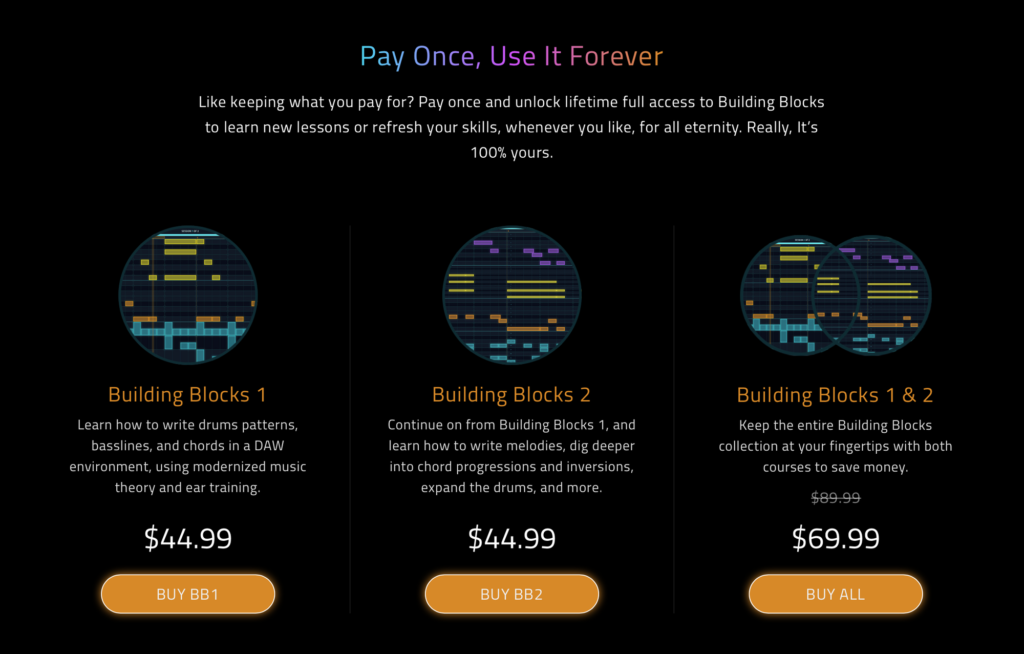
What I liked
Well, honestly I liked everything about this course from the style of learning, the interface, the lessons, the exercises, and the breath of content.
It is just as easy to simply do 10 minutes a day or 1 hour a day. I really liked the fact that the lessons are broken down into such easily digestible sections because. I feel like I can make progress no matter how much time I am actually able to put in.
And because of that, I don’t have this all-or-nothing mindset that says I need to at least do this for 30 minutes…..which is a major problem I have with practicing guitar….you ever have that feeling with practicing an instrument or other projects?
I also honestly like the difficulty of the exercises.
You will know what I am talking about once you get into the Mind’s Ear lessons in Building Blocks 2.
Final Thoughts
Where other ear training and music theory courses have, been forgotten and hid under my metaphorical bed. The challenges and exercises in Building Blocks keep bringing me back every day. I look forward to trying to get through a few Challenges or Mind’s Ear exercises every day. It has definitely become a habit for me, which is saying a lot because forming good habits is extremely difficult for me.
I started with the 3 day free trial that they offer. I wonder how many lessons you can complete in those 3 days….let me know in the comments!

